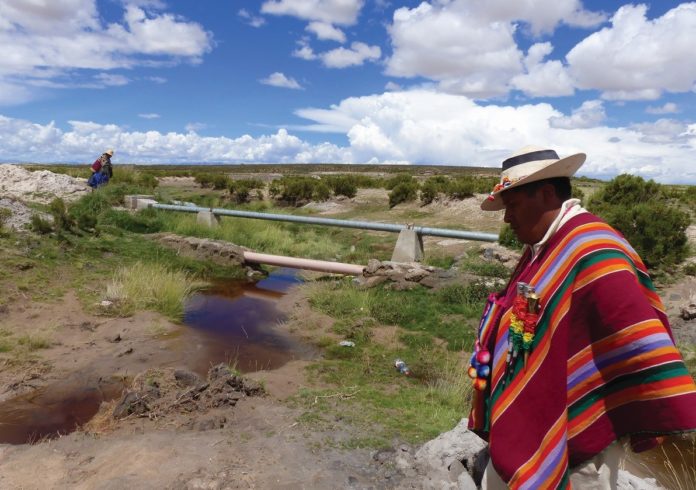
With the deadline for the SDGs a decade away, Sergio Campos, chief of the Inter-American Development Bank’s Water and Sanitation Division, reviews the priority challenges and opportunities for Latin America and the Caribbean.
Latin America and the Caribbean (LAC) has more than one third of the freshwater resources of the planet and less than 10% of the global population. Between 1990 and 2015, the proportion of people with access to water grew from 85% to 95%, and the proportion of people with improved sanitation grew from 67% to 83%.
Nevertheless, the region has yet to achieve universal access to water and sanitation – both aims of the UN Sustainable Development Goals (SDGs). The task is becoming increasingly difficult to achieve because of the geographic distribution of populations, climate change, and mass urbanisation.
To create effective, sustainable solutions, programmes should focus on improving the lives of vulnerable populations and ensuring water security by strengthening local governance and finance organisations. Governments should work on ensuring water quality, and on reducing wastewater pollution, strengthening water governance, boosting efficiency, and protecting natural resources and watersheds.
Challenges
Urban vs rural. The difference in access to water and sanitation is particularly stark between urban and rural areas. According to 2017 data, 15.48 million people in rural areas do not have basic access to potable water and 38.48 million people still lack sanitation. This is while more than 90% have access to water and sanitation in many cities. Ethnic populations, including indigenous and Afro-descendants, have the lowest rate of access to potable water and sanitation. Furthermore, traditional infrastructure solutions often do not work in rural areas.
Climate change. As climate change precipitates droughts and floods, water security is at risk in cities and the countryside. In Latin America and the Caribbean, water scarcity affects nearly 230 million people, threatening the health and safety of communities by impacting hygiene and causing mass migration. One fourth of the region is arid and all areas are susceptible to drought. Although Brazil hosts a fifth of the planet’s water resources, it suffered a series of droughts in 2017 that debilitated the northeast’s rural populations. Utilities play a key role in managing demand in areas with limited water resources and so must be supported.
Inequality. The entire region is urbanising rapidly. The population of more than 140 cities is expected to double in the next 20 years. In 2014, 881 million people lived in informal settlements worldwide. That number is expected to swell to two billion by 2030. Low-income and vulnerable populations are most likely to lack basic services, as they often live in informal communities that are not connected to the city’s water network. Even when they do have access, low-income populations have difficulty in affording continuous and safe water. Furthermore, low-income and vulnerable populations do not have the political power to improve their living conditions because of weak institutions. Women, although responsible for collecting water for the household, are frequently excluded from water infrastructure decisions.
Governance. It is no longer enough to provide access to water and sanitation; institutions must also strengthen local governance and finance structures to adapt to the changing needs of the region. Between 30% and 60% of water is lost because of leakage, and less than 20% of the region’s wastewater is treated, compared with 60% in high-income countries. Approximately 200 million people receive non-continuous service, meaning they have access to water for less than 24 hours a day. If we factor in aspects such as water quality and pressure to access data, service coverage would drop by around 20%. So, we need to invest in existing infrastructure.

Opportunities
Operations. These challenges appear significant, but some cities have been moving in the right direction. For example, since the 1980s, Uruguay’s capital, Montevideo, has worked with the Inter-American Development Bank (IDB) to develop effective water and sanitation plans. It recently built underground retention tanks in five key areas of the city to reduce the likelihood of floods. Montevideo is also working to treat wastewater from the western neighbourhoods of the city. Once this project is completed, more than 90% of the population will have access to sanitation. Other cities should follow Montevideo’s example.
Knowledge. The IDB has developed several tools to help countries strengthen their water sector. AquaRating is a system based on an international standard for the evaluation and improvement of water and sanitation utilities. Developed in collaboration with the International Water Association (IWA), it offers a comprehensive and impartial evaluation of the utilities’ performance, best practices and reliable information. AquaRating has three primary goals: to improve the management of utilities, build knowledge, and diversify application schemes. In 2018, it was implemented in more than 15 countries and 60 water and sanitation companies. It serves as a reference model for regulators, governmental institutions, development agencies, and financers, such as the State Secretariat for Economic Affairs, the Asian Development Bank, the Millennium Challenge Corporation, and the World Bank.
It is impossible to speak of sustainable development without ensuring quality water and sanitation for all. Ten years ago, the UN General Assembly recognised water and sanitation as human rights. Similarly, SDG 6 outlines goals, targets and indicators to ensure availability and sustainable management of water and sanitation for all. Each of these is key to reaching water-related goals such as health, nutrition and food security, education, and gender equality.
If we keep investing in sanitation at current rates, it will take 100 years to reach the SDG 6 objectives. It is time to accelerate action. The key is to strengthen institutions and work with all sectors to guarantee access to services while protecting our resources and offering financing solutions – including for the most vulnerable populations.
For more information, see:







